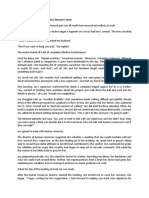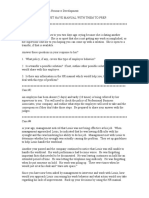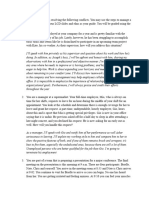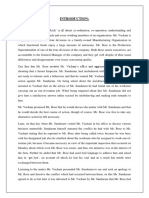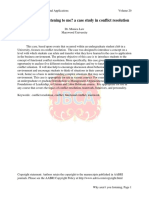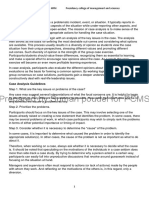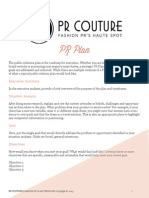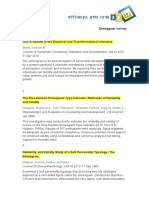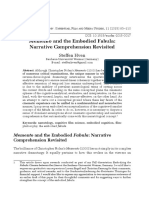MADS 6608
Class Exercise on Conflict
Each case incident below describes a conflict that was eventually resolved. Please identify the
original source of the conflict, the modes of conflict management that were adopted,
To aid in your analysis, use information in the table below as a summary of the relevant
concepts.
Sources of conflict include: Modes of managing conflict include:
1. Group identification and intergroup 1. Avoiding
bias 2. Competing
2. Interdependence 3. Compromising
3. Differences in power, status and 4. Accommodating
culture 5. Collaborating
4. Ambiguity
5. Scarce Resources
Case #1
Two people have computer breakdowns on the same day, but there is only one IT person for
the whole company. Both people worry that if their work does not get done or they lose files
they have stored on their computers, but have not backed-up, they could get fired. Because of
this, each person believes that the IT person should solve his/her problem first and deal with
the other person’s problem second. They both call, email, and text the IT person repeatedly
and they both show up at the IT office demanding help at the same time. Neither person
relents. They both think their problem is the most important problem and the IT person, who
has more calls for help than he/she can possibly answer, eventually leaves his/her office to do
another service call without helping either person. Both people are frantic; one calls a friend
who is a tech-geek to see about getting help from someone outside the company; the other
person feels his/her blood pressure rising, pretends to have come down with the flu and takes
the rest of the day off.
Case #2
A man and a woman on a hiring committee disagree as to who is the best person to hire. The
man believes that men are more qualified and prefers to hire a male applicant, whereas the
woman believes that women are more qualified and prefers to hire a female applicant. An
impasse arises when the two cannot agree as to which applicant should be offered the job. The
man does not give up his position; he continues to explain why male applicants are better and
reiterates data that supports his point based on recent hires. The woman thinks this is a classic
example of the hostile environment that women face at the company, and realizes that
�changing the culture in the company may be a struggle for many of the men who are currently
working there.
In the end, the woman wants to maintain a good relationship with her male colleague and she
is tired of fighting a constant battle with him. She decides that maintaining the peace for now is
more important than hiring a female applicant she doesn’t even know. She defers to her male
colleague and lets him make the choice; they hire the male applicant. When she gets home,
she drinks half a bottle of wine and tells herself that her colleagues’ decision was probably the
right one anyway because the male applicant probably was better qualified than the female
applicant.
Case #3
A boss faces a day of annual performance evaluation meetings. In the first meeting, the
employee thinks that s/he exceeded performance expectations over the past year and deserves
a raise to recognize her/his good work. The boss thinks that the employee’s performance met
expectations, but did not exceed them. The boss feels a lot of pressure to get the performance
evaluation correct. He/she does not want the employee to quit, but also does not want to
exceed his/her annual budget for salaries. During the meeting, the employee and his/her boss
argue about whether the employee will get a raise and how much it will be. The employee
expresses his/her understanding of the performance standards, provides more detail about
his/her accomplishments over the course of the year, and explains how important it is to
him/her for good work be recognized. In turn, the boss clarifies the company’s perspective on
the performance standards, explains his/her budgetary constraints, and reviews the employee’s
accomplishments. After a long and heated discussion, the boss agrees to amend the employees
performance appraisal to reflect the additional accomplishments that the employee pointed
out, and offers the employee extra days of paid vacation to recognize his/her hard work. Both
the boss and the employee walked away fully satisfied. The employee felt recognized for
his/her accomplishments and the boss kept a good employee while maintaining his/her budget.
At the same time, the whole exchange was draining for the boss, who walked into the next
meeting wondering how he/she was going to make it through the rest of the day dealing with
similar meetings. Each person seemed to want their own personal deal and the boss simply
didn’t have the energy to consider all their individual accomplishments and troubles. The boss
wished he/she could just give everyone the same deal and be done with the whole process.











